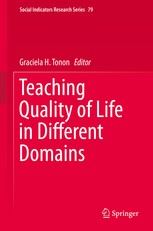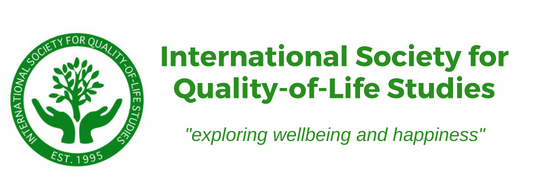Teaching Quality of Life in Different Domains
Editors: Tonon, Graciela (Ed.)
Social Indicators Research Series 79- Springer © 2020

The aim of this book is to present proposals to teach quality of life in different field. It is organized in 15 chapters, each of them dedicated to different fields.
In Chapter 1 the editor presents the proposition of quality of life (theoretical/methodological) as a possibility to construct a new outlook on the social field studies and to propose a course that includes the vision of quality of life in a Master/PhD Program in Social Sciences. In Chapter 2, Dan Weijers discusses the methods, topics, and perspectives that characterize a philosophical approach to teaching well-being or quality of life and concludes with some suggestions on how to harness the subject matter in a way that creates an engaging undergraduate-level course on well-being and quality of life.Tobia Fattore in Chapter 3 examines different ways in which well-being and quality of life can be used as pedagogical concepts for teaching Sociology. The chapter begins with a first overview of key philosophical traditions in quality-of-life research for introducing some foundational sociological theories and ways of undertaking social research. In Chapter 4, Daniel T. L. Shek, Xiaoqin Zhu, Diya Dou, Moon Y.M. Law, Lu Yu, Cecilia M.S. Ma, and Li Lin present two programs in response to the results of the research studies that showed worsening mental health conditions such as rising depression and suicidal rates, the increase of adolescent egocentrism, and the declined of empathy and sense of social responsibility among university students. To promote holistic development and quality of life in undergraduate students, two credit-bearing leadership subjects were presented. Chapter 5 is dedicated to the teaching of quality of life in relation with the capability approach. Paul Anand offers new insights into how the capability approach can now make a systematic and transformative contribution to higher education teaching focused on quality of life. In Chapter 6, written by Takashi Inoguchi, the author describes how political science courses on quality of life may be organized with a syllabus that consists of the following six sections: people’s satisfaction with daily life, people’s approval of government conducts especially economic policy, parents’ propensity to nurture their children norms and values, QOL and confidence in institutions, QOL-based societal profiling or typology of Asian societies, and Applying QOL studies in Sustainable Development Goals. Don R. Rahtz, M. Joseph Sirgy, Stephan Grzeskowiak, and Dong-Jin Lee examine in Chapter 7 different ways in which quality-of-life concepts can be integrated into existing marketing coursework. The ultimate goal is to increase the likelihood that students would embrace a QOL orientation in the practice of marketing. The final section ends with a set of suggestions for moving the acceptance of the broader use of QOL-related concepts in marketing departments, the business academy. Chapter 8 was written by Filomena Maggino who presents the case of a post-master program dedicated to the training of statisticians in the field of quality of life. In Chapter 9, Jon Hall comments how statisticians, economists, and policy makers around the world are working to design and use alternative measures of human progress. This chapter discusses some of the ways in which education and training can foster and support this work. In Chapter 10, Jorge Guardiola proposes Nonviolent Economics as a path for achieving quality of life, presenting an experience of addressing quality of life in an Economic Policy course. Matías Popovsky in Chapter 11 presents the importance of teaching quality of life using online education, which means conducting a course partially or entirely through the Internet and presents a model for online courses and degree programs. Javier Martinez in Chapter 12 presents an approach for teaching and learning quality of life in urban studies. It is contextualized within two higher education courses in an MSc specialization on Urban Planning and Management with a group of international students in the last 10 years. Chapter 13 is dedicated on the teaching of quality of life and well-being in Public Health. Chelsea Wesner, Diana Feldhacker, and Whitney Lucas Molitor propose the social ecological model of health as an organizing framework, considering that it is an innovative and integrated approach to teaching that aims to create quality learning experiences. Chapter 14 by Diane E. Mack, Philip M. Wilson, Caitlin Kelley, and Jennifer Mooradian presents how to teach well-being within the context of sports through four evidence-based modules. At the end the chater focuses on distinct groups of athletes including sport participants living with physical and intellectual disabilities, athletes undergoing injury rehabilitation, and current/former athletes transitioning beyond sport. Finally in Chapter 15, Sabirah Adams, Shazly Savahl, Maria Florence, Kyle Jackson, Donnay Manuel, Mulalo Mpilo, and Deborah Isobell aim to briefly sketch the extent of quality-of-life research relating to children in South Africa and to propose a syllabus for training emerging researchers in conducting QoL research.
